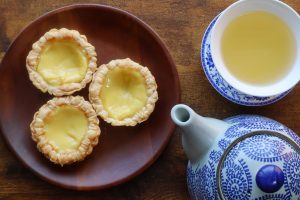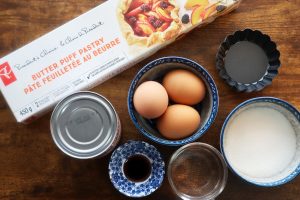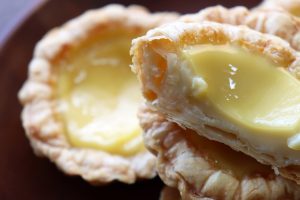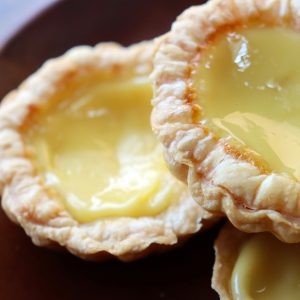Hong Kong Egg Tart (Bánh Tart Trứng Hồng Kông)

The Hong Kong Egg Tart has its origins deeply rooted in the city’s colonial past and is a perfect reflection of Hong Kong’s blend of Eastern and Western influences. Its development was heavily inspired by two culinary traditions: the British custard tart and the Portuguese pastel de nata.
When Hong Kong became a British colony in the 19th century, British culinary traditions made their way into the local food culture. The custard tart, a popular British pastry, was introduced in bakeries and tea shops, where it gained significant attention. However, the traditional English custard tart uses shortcrust pastry and is often served cold.
On the other hand, Macau, a neighbouring region that was once a Portuguese colony, brought the pastel de nata into the region. This pastry features a flaky crust with a rich, creamy egg custard, served warm.
Hong Kong’s inventive chefs combined elements of these two influences, making adjustments to suit local tastes. They replaced the shortcrust pastry with the more delicate and buttery puff pastry, which became one of the key features of the Hong Kong-style egg tart. Additionally, the custard filling was simplified, using just a few ingredients such as eggs, sugar, and evaporated milk, resulting in a lighter, silkier filling compared to the richer British version.
Today, Hong Kong Egg Tarts are a staple in cha chaan tengs (Hong Kong-style diners) and bakeries throughout the city. They are best enjoyed freshly baked and are often served alongside milk tea or other popular beverages. The egg tart has also become an iconic treat, symbolizing the city’s unique fusion of cultural influences and culinary creativity.
Making Hong Kong Egg Tarts at home is surprisingly easy. Although the traditional method can be a bit challenging, there’s a simpler alternative that uses store-bought puff pastry along with basic ingredients like eggs, sugar, evaporated milk, and vanilla extract. With just about an hour for preparation and baking, you’ll have delicate, delicious tarts ready to enjoy.

Here are a few notes on my Hong Kong Egg Tart recipe:
- The classic tart shell for Hong Kong Egg Tarts is traditionally made by layering a lard dough and a water dough together, a process that creates the signature flaky texture. However, this technique can be quite challenging and time-consuming. In this recipe, I simplify the process by using store-bought butter puff pastry, which still delivers that deliciously crispy, flaky texture while being much easier and quicker to handle. For the filling, you only need a few basic ingredients: sugar, evaporated milk, eggs, and vanilla extract.
- I use 3-inch round nonstick tart molds, but if you don’t have them, a muffin tin works just as well.
Q&As on Hong Kong Egg Tart
1. What is evaporated milk, and do I have to use it for making Hong Kong Egg Tarts?
Evaporated milk is milk that has had about 60% of its water content removed, giving it a thicker, creamier consistency compared to regular milk. It also has a slightly caramelized flavour due to the heating process. In Hong Kong Egg Tarts, evaporated milk is traditionally used to create a rich, smooth custard filling. While you can substitute it with regular milk or cream in a pinch, using evaporated milk will give you the most authentic texture and taste.
2. What is the difference between Hong Kong Egg Tarts and Macau or Portuguese-style Egg Tarts?
The main difference lies in the crust and the custard filling. Hong Kong Egg Tarts typically have a smooth, buttery puff pastry crust and a light, silky custard made with evaporated milk, giving it a delicate sweetness. Macau or Portuguese-style Egg Tarts, on the other hand, have a caramelized, slightly blistered custard with a richer texture and deeper flavour, often using cream in the filling. The crust for Portuguese tarts is also puff pastry but tends to be thicker and more golden. These variations give each tart its distinct character and regional flair.

3. How many tarts can I make with this recipe?
With store-bought puff pastry, this recipe typically yields about 9-12 tarts, each with a 3-inch diameter. The exact number may vary slightly depending on the size and thickness of the puff pastry sheet you’re using.
4. Why do I need to poke a few holes in the bottom of each pastry shell before filling it with custard?
Poking small holes in the bottom of each pastry shell, known as “docking,” helps release steam as the tarts bake. This prevents the pastry from puffing up too much, ensuring it stays flat and crisp, which is important for holding the custard filling securely and evenly.
5. How do I store leftover tarts?
To store leftover egg tarts, place them in an airtight container and keep them in the refrigerator for up to 3 days. When you’re ready to enjoy them again, reheat the tarts in a 350°F (175°C) oven for about 5-10 minutes. This will warm up the custard and restore the crispiness of the pastry for the best texture and flavour. Avoid microwaving, as it can make the pastry soggy.

Recipe for Hong Kong Egg Tart (Bánh Tart Trứng)
Equipment
- 1 oven
Ingredients
- 225 grams (or 1 sheet) butter puff pastry
- 2 whole eggs + 1 egg yolk
- 80 grams sugar
- 75 grams evaporated milk
- ½ teaspoon vanilla extract
- ⅔ cup hot water
Instructions
- Prepare:Preheat your oven to 350°F (175°C).In a small mixing bowl, combine the sugar and hot water. Stir continuously until the sugar fully dissolves into the water. Set this mixture aside to cool.Lay the puff pastry sheet flat on a lightly floured surface. If the sheet is too thick, gently roll it out with a rolling pin until you reach your desired thickness, making sure it's even across the surface.Use a round dough cutter to cut 9-12 circles from the pastry sheet. Gently press each pastry circle into the egg tart molds, making sure the dough fits snugly along the bottom and sides of the mold without any gaps.In a separate mixing bowl, whisk together the 2 whole eggs, 1 egg yolk, evaporated milk, and vanilla extract until well combined. Slowly pour in the cooled sugar syrup, whisking constantly to incorporate. For a silky texture, strain the custard mixture through a fine mesh strainer to remove any lumps.Arrange the tart molds on a baking sheet. Using a fork, gently poke a few holes in the bottom of each pastry shell to allow steam to escape during baking and keep the crust from puffing up.Pour the prepared custard mixture into each tart shell, filling them just below the rim to avoid spills while baking.If any foam has formed on the surface of the custard, use a spoon to skim it off, ensuring the top is smooth and even before baking.
- Bake:Place the baking sheet with the tarts in the preheated oven and bake for approximately 25 minutes, or until the pastry turns golden brown and the custard is set. Be sure to monitor the tarts to prevent over-browning.
- Serve:Once baked, remove the egg tarts from the oven and allow them to cool slightly on a wire rack. For the best taste and texture, serve the tarts while still warm and fresh, preferably on the same day they are baked.

